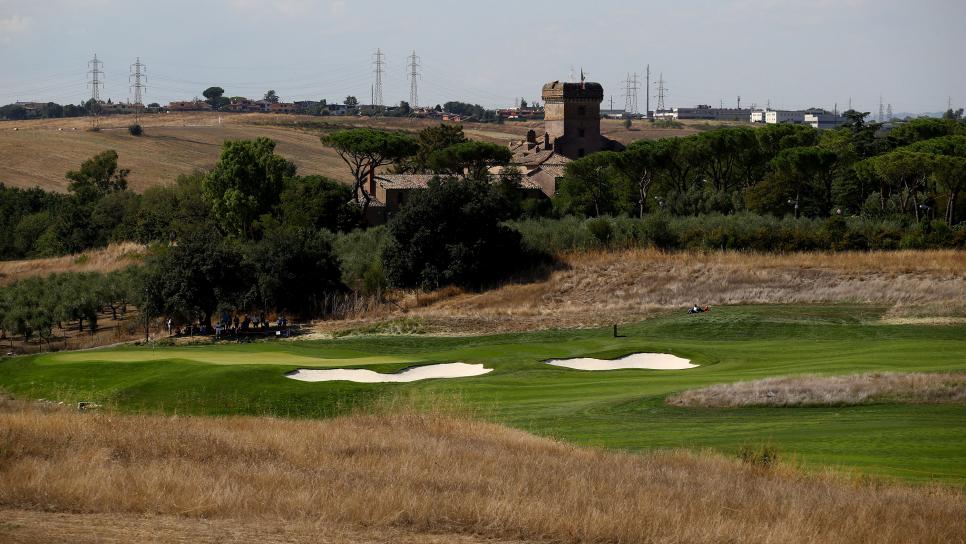The reviews are in. Some of them anyway. And the verdict, as ever where golf courses are concerned, is mixed. Depending on who you talk to, the Marco Simone Golf Club just outside Rome – venue for last week’s Italian Open on the European Tour and what will be the 44th Ryder Cup in 2023 – is either a disaster waiting to happen or just another in a long line of so-so Old World venues for the biennial contest between Europe and the United States.
The original design by Jim Fazio and David Mezzacane is long gone and mourned by seemingly no one, which is not really surprising. Here’s the tip-off. Although the “old” course was deemed good enough to host the 1994 Italian Open won by Eduardo Romero, the event never returned. Clearly, there were issues.
So it was that, in order to be the last course standing in a bidding process that also included Germany, Austria and Spain, Italy’s first Ryder Cup venue was told to reconstruct all 18 holes ahead of the competition. Surely the most peculiar ask for a course hoping to hold an event of this stature.
“The initial goal was always to stage the 2021 Italian Open at Marco Simone,” says Guys Kinnings, the European Tour Ryder Cup director. “So the extra year we have been granted for the Ryder Cup is a bonus, really. The 2023 Italian Open will obviously be earlier in the year than in 2021 and 2022. But we did that same thing with the French Open in 2018. I can’t say any of that with certainty, but we’d like to give the players, sponsors and the Italian Federation as much exposure to the venue as we can before the Ryder Cup.”
OK, so what have we got now? What have Tom Fazio II (son of Jim) and Jeremy Slessor of European Golf Design come up with for this week and beyond, specifically for when the Americans come visit in 2023?
“No holes stood out for me,” says Englishman Oliver Wilson, who played in the 2008 Ryder Cup at Valhalla. “Which is the problem, really. The greens are immaculate, the surfaces brilliant. And yes, the undulations are nice and the green complexes are really good. But there are nine greens you can’t see when you are hitting your approach shot. There is so much elevation change. So the holes are not amazing. Not once did I think, This is a great hole.”
Other verdicts have been even less kind, to the point where more than one professional requested anonymity. Especially when the subject of the putting surface on the 200-metre (219-yard) par-3 seventh comes up.
“That green is horrendous,” says one player. “It looks like a cartoon where the character pulls up quickly and the ground curls up like a carpet. I watched one player chip his ball one yard onto the green and it finished over the back. Of a green that is 47 yards long.”
“The front half of the green is fine, but the back half is ridiculous, unless you are hitting a wedge,” says another competitor. “[Saturday] it played 220 yards, which made it impossible to hit that part of the green.”
And one more:
“The seventh green is appalling. It looks like the shaper was on a mission to screw the architect. They can’t be friends. So many waves and slopes and humps, it’s just too much. I’m not sure what they were trying to do. And these are the people who are building our arenas. It’s shocking.”

For all the concerns about the seventh, perhaps most troublesome is just the overall hilly site. As Wilson noted, as many as nine greens are sited well above the fairways, leaving the players struggling to see more than half of the distant flagsticks.
“I didn’t have the highest expectations and they have pretty much been confirmed,” sighs one player. “It is quite hilly, almost as much as Crans last week [the Swiss course that hosted the European Masters]. There are a few holes that are 10 to 15 yards up or down. On half of the course, we are down below hitting up to greens where we can see only the top of the pin. That’s not something I take great pleasure in.”
On the other hand, that harsh view is not universal. Former European Tour player Jay Townsend sat in the commentary box for Sky Sports last week.
“The greens really reward good shots,” insists the American. “Yes, there are some uphill holes. And yes, they always leave a little to be desired. But if a course is hilly, you have uphill holes. The rough is fine and consistent. The lies looked pretty much the same to me. There are a couple of immature spots on the fairways. But as young as the course is, it is in great condition. And the greens are as good as any putting surfaces I have ever seen. If you hit a good putt, it is going in. There are no imperfections out there.”
Indeed, the green surfaces have met with almost unanimous approval. But the combination of severe slopes and setup? Not so much.
“You would not want the course to get too firm,” insists another player. “Plus, I’m not sure why we would build a course that would favour the Americans more than the Europeans. But I feel that is the case. Historically, the Americans have been longer than us. And here there are a few places where you can really cut the corners if you bomb it. Also, putting on undulating, quick greens is what the Americans are more used to. On both counts, we will likely be at a disadvantage. Yes, we can help things with the setup. But I’m not as impressed as I would like to be. Yes, it has time to mature before 2023. But it needs a manicure and a pedicure to get up to standard.”
Still, as everyone in golf knows, there is more to a Ryder Cup than just the quality of the 18 holes on display. With so little golf to actually watch – especially on the first two days when only four matches are on the course at any one time – the spectating experience is an important aspect to consider. Count Eddie Pepperell as a fan of that aspect of Marco Simone.
“This is a good matchplay course and built perfectly for crowds,” contends the Englishman. “There are plenty of hills to stand on, so I think it will be a good venue. It has clearly been built with the Ryder Cup in mind. They’ve thought about the fans. There are plenty of high spots around the greens, creating amphitheatres. That’s all good. I’ve never been of the opinion that a Ryder Cup course has to be spectacular. It just has to be a great spectacle. This course has enough of that.”
Speaking of which, the closing holes at any Ryder Cup venue ideally have to be capable of producing thrills and spills, birdies and bogeys. And here again, the architects seem to have got things right. From the 14th tee onwards, the players will be faced with a pair of stiff par 4s, a potentially driveable par 4, a really tough par 3 and, to finish, a water-laden par 5 [pictured, top] where any number from 3 to 7 is in play.
“The 14th and 15th are two very good par 4s,” Pepperell continues. “You need to hit two very good shots on both to have a birdie chance. They can easily make the 16th driveable, and 17 is a brilliant par 3, maybe the best hole on the course. The green is long and thin with trouble on both sides. The 18th is a par 5 with all the ingredients to produce an exciting climax. Things will happen on those holes.”

While that remains to be seen, what is not in question, is that the course clearly requires time to “bed-in”. Open only since March, there are obvious and understandable signs of immaturity. Some of the “coarse” grass to be found on the fairways provoked negative comments from a number of players as did the patchiness of the rough. There were also a few (legitimate) moans and groans from those not blessed with huge power off the tee.
“Today I was in the middle of a fairway, on a downslope, hitting a 5-iron to a green way above me,” says Matt Fitzpatrick, a 2016 Ryder Cupper who will probably be playing again for Europe later this month at Whistling Straits. “It made no sense. I’ve hit a good drive, I’m in what should be the ideal spot, and I couldn’t keep my ball on the green.”
Still, with two more competitive opportunities to come before the Ryder Cup makes its way to Italy for the first time, European Tour players should by 2023 be reasonably familiar with the foibles of this new venue. More so than the Americans, anyway. The mind goes back to Paris National two years ago. There, European skipper Thomas Bjorn set up the course up to suit his team, 12 men who had played the course multiple times.
In contrast, only Justin Thomas, who not coincidentally was the most successful US player at that Ryder Cup with a 4-0-1 record, took the trouble to familiarise himself with the premises by playing in the French Open three months earlier.
“Based on what happened in 2018, the Americans need to come over and play,” Townsend says. “Only JT did that then. And he played the best of the Americans by far in the Ryder Cup. The course over-required some local knowledge, and time will tell us that this one does, too.”
TOP/MAIN PHOTO: Luke Walker




